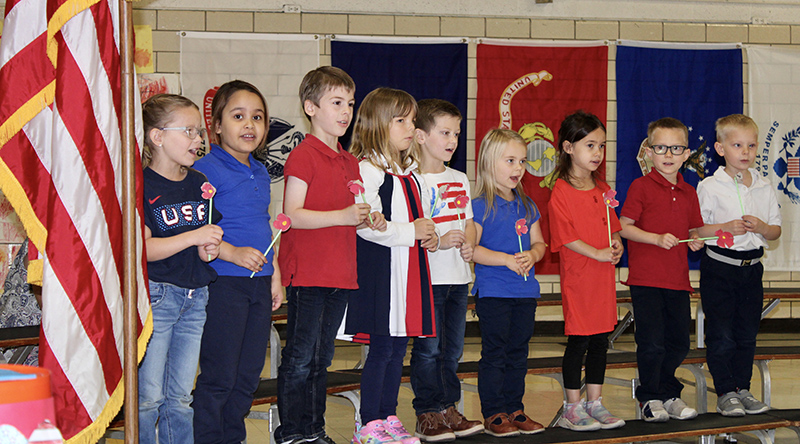
Mrs. Seybold’s kindergarten class at Cathedral School in Superior hold handmade red poppies during a song performance for the school’s Veteran’s Day program held on Nov. 11. (Catholic Herald photo by Jenny Snarski)
Jenny Snarski
Catholic Herald Staff
An annual tradition returned to the Annabring Gymnasium at Superior’s Cathedral School on Friday, Nov. 11, after a two-year pandemic hiatus.
The Veteran’s Day program was started many years ago by Cathedral teacher Ginny Leopold. She later asked colleague April Campbell, who teaches third grade, to take it over.
Campbell admitted she had been unsure of the turnout after two years, but was pleased by the “spectacular crowd” that filled the gym’s bleachers. School children were dressed in patriotic attire.
Knights of Columbus honor guard were present as the flag was brought into the space by a female member of the military. An introduction was made with prayer, the Pledge of Allegiance and playing of the national anthem by two students.
Each grade then performed a song or other spoken poetic memorial interspersed with an explanation of the history of Veteran’s Day and a moment of recognition of all veterans in attendance.
While the Treaty of Versailles wasn’t signed until late June 1919, the origin of Veteran’s Day – Armistice Day – commemorated the end of fighting in “the war to end all wars” which took place on the 11th hour of the 11th day of the 11th month in 1918. In November 1919, President Woodrow Wilson proclaimed the first commemoration, and Congress passed a resolution in 1926 to make it a federal holiday, which didn’t pass until 1938.
Although those designating the original holiday had hopes that “The Great War” would be the only such conflict, after World War II broke out, the celebration was later renamed Veteran’s Day to honor all veterans
What began as Armistice Day celebrated on Nov. 11 was later moved to October but returned to its original date in 1975 with the desire to not change the date, which was historically significant, to a more convenient arbitrary schedule.
During the Cathedral School’s ceremony, veterans were honored with the gift of a packet of poppy seeds, after which the poem “In Flanders Fields” was read.
“In Flanders Fields” was written by John McCrae, a Canadian physician, poet and soldier, after spending more than two weeks caring for those injured in an April 1915 battle in Northwestern Belgium.
The publication of the verse led to the adoption of the poppy in Britain and the Commonwealth as a flower of remembrance for their dead. The small red flower was then adopted by the National American Legion as their official symbol of remembrance in 1920.
The final presentation of the program was the sixth grade symbolically setting an empty table in memory of all prisoners of war and those missing in action, explaining each item as it was set in place. Item by item, they added a white tablecloth, single red rose with a ribboned vase, a slice of lemon, sprinkling of salt, empty glass, lit candle and the American flag.
As visitors left the gymnasium, they walked past a display of “Veteran’s Day Heroes.” Dozens of sheets of paper, most with photos attached, with information that included the veteran’s name, the branch of military they served with, for how many years and who they were a family member or friend of in the school community.
